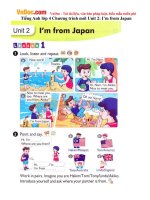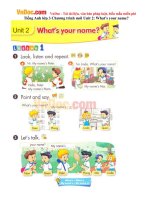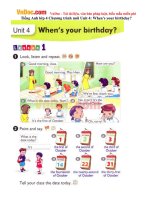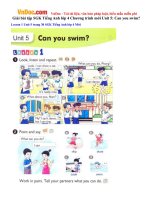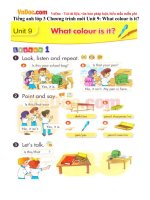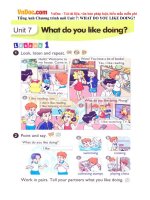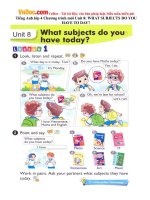Anh 4 chuong trinh moi Unit 9 What are they doing
Bạn đang xem bản rút gọn của tài liệu. Xem và tải ngay bản đầy đủ của tài liệu tại đây (221.48 KB, 15 trang )
<span class='text_page_counter'>(1)</span>Week: 14 Period:27. Date: Thứ …..ngày ….tháng …. năm 2015. Teaching date: ............................................ UNIT 9: What are they doing? Lesson 1 I. Objectives: By the end of this unit, pupils can use the words and phrases related to the topic Classroom activites. Ask and answer questions about what someone is doing, using What’s he/she doing? He’s/ She’…. II. Language Focus: + Vocabulary: watching a video, writing a dictation, reading a text, listening to music... + Sentence pattern: What’s he/she doing? He’s/ She’…. III. Resources: Ss’ book, recording, computer, stereo, (projector), picture of activities, ... IV. Procedure: Time. 3’. 8’. Learning activities. Language Focus. Warm-up: - Ask pupils to play Bingo to revise verbs for Spoken learning activities in the classroom (e.g. read, Interaction. write, listen, talk). Follow the proceduce in Games in Introduction. 1. Look, listen and repeat. Spoken interaction - Tell pupils that they are going to read a story in which pupils ask and answer questions about what someone is doing in the classroom. - Ask them to look at the four pictures to identify the characters ( Mai, Nam, Tom and Peter) and the context in which the language is used. Ask questions such as Where are they? What are they doing? ( In picture a, Nam is holding a ball in his hand, standing with Peter and Mai What’s he doing? And Mai answers He’s reading. In Picture c, Nam asks Tom what he is reading. In Picture d, Nam suggests to the boys that they play football and the boys agree.) Remind pupils of the meaning of be + verb-ing. Check comprehension. - Play the recording more than once, if necessary,. Modes. Whole class. Whole class Individuals. Whole class.
<span class='text_page_counter'>(2)</span> 10’. 8’. for pupils to listen and reapeat. Do choral and individual repetition, pointing to the characters speaking * Language note: be + verb-ing is used to express an action happening at the moment of speaking (e.g They are making a boat.) 2. Point and say. - Tell pupils that they are going to practice asking and answering questions about what someone is doing. - Have them look at the bubbles and the pictures to understand how the language. Ask pupils to look at the four pictures to identify what the girl/boy is doing in each pictures. (Teacher: What’s she doing? Pupil: She’s watching a video.) Ask pupils to say the sentences chorally and individually. Repeat the same procedure with the rest of the pictures. - Ask pupils to practise in pairs, using the prompts in the bubbles and the pictures. - Select some pairs to role-play the dialogue in front of the class. * Language note: Draw pupils’s attetion to the ing-forms of different verbs (e.g. write writing.) ***Work in pairs. Ask and answer questions about your school. Ask its name and where it is. - Tell pupils that they are going to practise asking and answering questions about what one of their classmates is doing in the classroom, using What’s he/she doing? And He’s/she’s… You may ask pupils to mime different activites (e.g. reading, listening to music, playing football). - Ask them to work in pairs: one pupil asks the question and the other gives the answer. - Select some pairs to role-play the dialogue. 3. Listen and tick - Tell pupils that they are going to listen to three dialogues about what someone is doing and tick the correct pictures. - Ask them to look at the pictures to identify the similarities and differences among them (1a. Linda. Individuals. Pairs. New words and structures/ function Groups. Listening Activities. Whole class Individuals.
<span class='text_page_counter'>(3)</span> is writing. 1b. Linda is reading. 1c. Linda is listening to music. 2a. Nam is listening to music. 2b. Nam is reading. 2c. Miss Hien is reading and Nam is writing. 3a. Peter is listening to music. 3b. Peter is reading. 3c. Peter is watching a video or playing a game.) Check understanding. - Play the recording more than once, if necessary, for pupils to listen and tick the correct pictures. - Play the recording again for pupils to check their answers. - Get pupils to swap their answers before you check as a class. *Key: 1b 2c 3a Audio script: 1. Tom: Where’s Linda? Mai: She’s in the library. Tom: What’s she doing? Mai: She’s reading a book. 2. Tom: Where’s Peter? Mai: He’s in the computer room. Tom: What’s he doing? Mai: He’s listening to music. 3. Tom: Where’s Nam? Mai: He’s in the classroom. Tom: What’s he doing? Mai: He’s writing a dictation. 5'. 4. Look and write. - Tell pupils that they are going to anwer the questions about what someone is doing, using the picture cues.. - Ask them to look at the four pictures to identify what the character in each picture is doing. Then ask pupils to read the questions and write the answers. Get pupils to work in pairs, if necessary. - Give pupils time to do the task independently. Go around offering help, if necessary. - Get them to swap their answers before checking as a class. If there is enough time, invite some pupils to read the complete questions and answers aloud. *Key: 1. He’s reading a book.. Pairs Groups. Whole class Words and structures. Individuals Closed – pairs. Open – pairs Groups.
<span class='text_page_counter'>(4)</span> 5'. 1’. 2. She’s writing a dictation. 3. He’s listening to music. 4. She’s watching TV/a video 5. Let’s Play. - Tell pupils that they are going to play Charades. Follow the procedure in Games in Introduction. - Divide them into groups of three. Pupil 1 mimes a classroom activity (e.g. reading a book, listening to music) without making any sounds or lip movements. Pupil 2 points to Pupil 1 and asks What’s he/she doing? Pupils 3 answers (e.g. He’s/she’s reading a book.) - The pupils in groups take turn asking and answering the questions. Monitor the activity and offer help, if necessary. * Home link: - learnt by heart the school activities. - practice asking and answering about what someone is doing.. Whole class Game Groups. Whole class. Anticipated problems: …………………………………………………………………………………………………… …………………………………………………………………………………………………… …………………………………………………………………………………………………… …………………………………………………………………………………………………… …………………………………………………………………………………………………….
<span class='text_page_counter'>(5)</span> Week: 14 Period:28. Date: Thứ …..ngày ….tháng …. năm 2015. Teaching date: ............................................ UNIT 9: What are they doing? Lesson 2 I. Objectives: By the end of this unit, pupils will be able to ask and answer questions about what people are doing, using What are they doing? They’re… II. Language Focus: Spoken interaction, words and structures/ function. * Sentence Patterns: What are they doing? They're making a paper boat. * Vocabulary: painting masks, making a puppet/ a paper boat/ paper planes, palying badminton... III. Resources: Ss’ book, recording, computer, stereo, (projector), poster, picture cards ... IV. Procedure: Time 3’. Learning activities. Language Focus. Warm-up: - Spend a few minutes revising the previous Spoken Interaction. lesson by calling some pupils to the front of the class to ask and answer questions about. Modes Whole class.
<span class='text_page_counter'>(6)</span> 7’. 6’. activities happening in the classroom, using What’s he/she doing? He’s/she’s… 1. Look, listen and repeat. - Tell pupils that they are going to look at a story in which pupils ask and answer questions about what pupils are doing in the classroom. - Ask pupils to look at the puctures to identify the context in which the language is used. Ask some questions such as Who’s the girl/boy? Where are they? What are they doing? (In Picture a, Tom and Linda are stading near the door of the classroom and are talking. In Picture b and Picture c, Linda talks about what pupils at the red, blue and yellow tables are doing, and Tom asks if they are having an Art lesson.) Check comprehension. - Play the recording more than once, if necessary, for pupils to listen and repeat. Do choral and individual repetition, pointing to the character speaking. Language note: they’re = they are 2. Point and say. - Tell pupils that they are going to practice asking and answering questions about what people are doing. - Have them look at the bubbles to understand how to ask and answer questions about what people are doing, using What are they doing? They’re … Ask pupils to look at the four pictures to identify what the pupils are doing in each picture. Teach the phrases painting masks, making a puppet, playing badminton and making paper planes. - Point to the first picture and model the task with one pupil, using the sentences in the bubbles and the phrase under the pucture. (Teacher: What are they doing? Pupil: They’re paingting masks). Ask pupils to say the. Whole class. Individuals. Spoken interaction Individuals Whole class Pairs. Individuals. Pairs New words and structures Say and Respond. Groups.
<span class='text_page_counter'>(7)</span> 10’. 6’. question and answer chorally and individually. Repeat the same procedure with the rest of the puctures. - Ask pupils to practise in pairs, one asking the question and the other giving the answer, using the prompts in the bubbles and the pictures. - Select some pairs to demonstrate the task in front of the class. 3. Let’s talk - Tell pupils that they are going to pratise asking and answering questions about where their classmates are and what they are doing, using Where is he/she? What’s he/she doing? Where are they? And What are they doing? Remind pupils how to use be + verb-ing to ask and answer about what people are doing at the moment of speaking. - Do the task with one pupil as a model. Put the sentences on the board and do choral and individual repetition. - Ask pupils to work in pairs, one pupil asking the questions and the other giving the answers about what their classmates are doing at the moment of speaking. Monitor the activity and offer help, if necessary. - Select some pairs to role-play in front of the class. 4. Listen and number. - Tell pupils that they are going to listen to a text about what some pupils are doing at break time and number the pictures. - Ask them to look at the pictures and identify what the characters in each picture are doing (In Picture a, they are playing badminton. In Picture b, they are making paper planes. In Picture c, they are making a kite. In Picture d, they are playing football.) Check understanding.. Whole class Individuals Pairs Groups. Spoken interaction. Whole class Individuals.
<span class='text_page_counter'>(8)</span> - Play the recording for pupils to listen and number the pictures. - Play the recording again for pupils to check their answers. - Get them to swap their answers before you check as a class. Monitor the activity and offer help, if necessary. Key: a2 b4 c3 d1 Audio script It is break time now. 1. The boys are playing football. 2. The girls are playing badminton in the playground. 3. The girls are making a kite. 4. The boys are making paper planes.. 5’. 5. Look and write: - Tell pupils that they are going to answer the questions about what the children are doing, using the picture cues. - Ask them to look at the four pictures to identify what the characters in each picture are doing. Then ask them to read the questions and write the answers, using the picture cues. Get pupils to work in pairs, ifnecessary. - Give pupils time to do the task independently. Go around offering help, if necessary. - Get them to swap their answers before checking as a class. If there is enough time, invite some pairs to act out the dialogues. *Key: 1.They’re painting a mask. 2. They’re making a kite. 3. They’re making paper planes. 4.. Pairs. Listening Activities. Groups. Writing activities. Whole class Individuals. Words and structures. Pairs.
<span class='text_page_counter'>(9)</span> They’re making a paper house. 2'. 6. Let's sing:. -Whole class. - Tell pupils that they are going to sing the song Supportive activities What are they doing? Teach the song, following to reinforce learning the procedure in Teaching the unit components in Introduction. - Have them read each line of the lyrics aloud. Check comprehension. - Play the recording all the way through. Ask. Song. pupils to do choral and individual repetition of the song line by line until they get familiarized. - Individual. with the pronunciation, the stress, the rhythm and the tune of the song. - Play the recording again and get pupils to sing along with the recording. - Divide the class into two groups: one sings the questions and the other sings the answers. The rest of the class sings the song together,. 1’. clapping hands. * Home link: - Practice asking and answering about what people are doing.. Whole class. Anticipated problems: …………………………………………………………………………………………………… …………………………………………………………………………………………………… …………………………………………………………………………………………………… …………………………………………………………………………………………………… …………………………………………………………………………………………………… …………………………………………………………………………………………………… …………………………………………………………………………………………………… …………………………………………………………………………………………………….
<span class='text_page_counter'>(10)</span> Week: 15 Period:29. Date: Thứ …..ngày ….tháng …. năm 2015. Teaching date: ............................................ UNIT 9: What are they doing? Lesson 3 I. Objectives: By the end of the lesson, pupils will be able to pronounce the sounds of the letters sk and xt in the words mask and text respectively. II. Language Focus: Spoken interaction, phonics. + sk mask He's making a mask. + xt text She's reading a text. III. Resources: Ss’ book, recording, computer, stereo, (projector), poster, sound card ....
<span class='text_page_counter'>(11)</span> IV. Procedure: Time. 3’. 8’. Learning activities Warm-up: - Spend a few minutes revising the previous lesson by calling some pupils to the front of e class to sing the song What are they doing? Have the class listen and clap their hands. 1. Listen and repeat. - Tell pupils that they are going to practise saying the sounds of the letters sk and xf in the words mask and text respectively. - First, put the letters sk and xf on the board. Play the recording and ask pupils to repeat a few times. Then put the words mask and text on the board, play the recording and ask pupils to repeat a few times. After that, write the sentences He's making a mask, and She's reading a text on the board. Play the recording a few times and let pupils say the sentences, paying attention to the target sounds. - Do choral and individual repetition of the sounds, words and sentences until pupils feel confident. - Get some pupils to say the sentences in front of the class. Check as a class and correct the pronunciation, if necessary.. Language Focus. Spoken Interaction. Game.. Modes. Whole class. Whole class Individuals Whole class Individuals Whole class Phonics.
<span class='text_page_counter'>(12)</span> 6’. 2. Listen and tick. Then write and say aloud: - Tell pupils that they are going to listen to the four sentences and tick the correct words. - Ask them to look at the sentences and guess the words to fill the gaps. - Play the recording so they can listen and tick the words. Remind pupils to focus on the words with the letters sk and xf while listening. - Play the recording again for pupils to check their answers. - Get them to swap their answers before you check as a class. Monitor the activity and offer help, if necessary. - Ask pupils to read aloud the sentences. Key: 1a 2a 3a 4b Audio scrip. Individuals. Pairs/ groups Phonics. 1. She's looking at the mask. 2, The desk is long. 3. She's drawing a desk. 4. They're painting a mask.. 10’. 3. Let’s chant. - Tell pupils that they are going to say the chant What's he doing? Follow the procedure in Teaching the unit components in Introduction. - Have them read the chant and check comprehension. - Play the recording more than once, if necessary, for pupils to do choral and individual repetition until they get familiarized with the pronunciation, the stress, the rhythm and the intonation of the chant. Show pupils how to chant and do actions. - Divide the class into groups of four and call two groups of pupils to give a demonstration: one group chants the questions, the other chants the answers.. Spoken interaction Whole class Individuals Pairs Groups.
<span class='text_page_counter'>(13)</span> - Get groups to sit opposite of each other and practise chanting and doing actions. Go around offering help, if necessary. - Call three groups to the front of the class to chant and do actions. The rest of the class claps along to the rhythm.. 7’. 4. Read and tick: - Tell pupils that they are going to read the text about what the pupils are doing and tick Tfor true statements or F for false statements. - Ask them to look at the statements first and then read the text, focusing on the information they need to do the task (what the characters are doing). If necessary, get pupils to work in pairs or small groups. - Give pupils time to do the task independently. Go around offering help, if necessary. - Get them to swap their answers before checking as a class. Provide explanations to the answers, if necessary. Key: IF. 5’. 2F. 3F. 4T. Whole class Individuals Pairs Groups. Reading activities. 5F. 5. Write about the picture: - Tell pupils that they are going to write a short paragraph to describe what the pupils are doing in their Art lesson, using the picture and word cues. - Have them look at the given words and guess what they are going to write. Then ask them to look at the picture and find out what the teacher, the girls and the boys are doing. - Have pupils work in pairs or groups to discuss what they are going to write. Give them enough time to do the task independently. - Get them to swap their answers before checking as a class. If there is time, ask one pupil to write the answer on the board.. Supportive activities to reinforce learning. Whole class Individuals Pairs. Words and structures Groups.
<span class='text_page_counter'>(14)</span> ***Key: The teacher is drawing a mask on the board.The girls are making puppets and painting masks.The boys are making a kite and painting houses.. 5’. 6. Project - Tell pupils that they are going to choose a photo of their family and describe what each of the family members is doing in the photo. - Ask them to look at their photos and find out what each person is doing. Then they should think of the words needed to describe the picture and make notes, e.g. mum - cooking, kitchen; dad reading, living room; sister - learning English, living room. - Get some pupils to do a demonstration in front of the class as an example before starting the activity. + Example: My mum is cooking in the kitchen. My dad is reading in the living room. My sister is learning English in the living room. - Call some pupils to the front of the class to describe their photos. Key:Pupils'own. 1’. Whole class Individuals. Supportive activities to reinforce learning. Pairs. Groups. answers. * Home link: - learnt by heart the chant, describe the photo.. Whole class. Anticipated problems: …………………………………………………………………………………………………… …………………………………………………………………………………………………… …………………………………………………………………………………………………… …………………………………………………………………………………………………… …………………………………………………………………………………………………… …………………………………………………………………………………………………… …………………………………………………………………………………………………….
<span class='text_page_counter'>(15)</span> …………………………………………………………………………………………………… …………………………………………………………………………………………………… …………………………………………………………………………………………………….
<span class='text_page_counter'>(16)</span>


